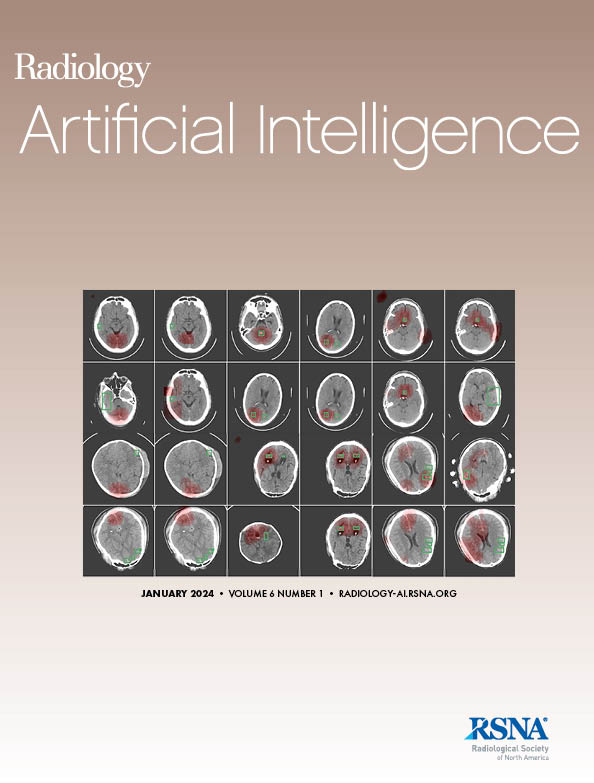William Lotter, Daniel S Hippe, Thomas Oshiro, Kathryn P Lowry, Hannah S Milch, Diana L Miglioretti, Joann G Elmore, Christoph I Lee, William Hsu
求助PDF
{"title":"Influence of Mammography Acquisition Parameters on AI and Radiologist Interpretive Performance.","authors":"William Lotter, Daniel S Hippe, Thomas Oshiro, Kathryn P Lowry, Hannah S Milch, Diana L Miglioretti, Joann G Elmore, Christoph I Lee, William Hsu","doi":"10.1148/ryai.240861","DOIUrl":null,"url":null,"abstract":"<p><p>Purpose To evaluate the impact of screening mammography acquisition parameters on the interpretive performance of AI and radiologists. Materials and Methods The associations between seven mammogram acquisition parameters-mammography machine version, kVp, x-ray exposure delivered, relative x-ray exposure, paddle size, compression force, and breast thickness-and AI and radiologist performance in interpreting two-dimensional screening mammograms acquired by a diverse health system between December 2010 and 2019 were retrospectively evaluated. The top 11 AI models and the ensemble model from the Digital Mammography DREAM Challenge were assessed. The associations between each acquisition parameter and the sensitivity and specificity of the AI models and the radiologists' interpretations were separately evaluated using generalized estimating equations-based models at the examination level, adjusted for several clinical factors. Results The dataset included 28,278 screening two-dimensional mammograms from 22,626 women (mean age 58.5 years ± 11.5 [SD]; 4913 women had multiple mammograms). Of these, 324 examinations resulted in breast cancer diagnosis within 1 year. The acquisition parameters were significantly associated with the performance of both AI and radiologists, with absolute effect sizes reaching 10% for sensitivity and 5% for specificity; however, the associations differed between AI and radiologists for several parameters. Increased exposure delivered reduced the specificity for the ensemble AI (-4.5% per 1 SD increase; <i>P</i> < .001) but not radiologists (<i>P</i> = .44). Increased compression force reduced the specificity for radiologists (-1.3% per 1 SD increase; <i>P</i> < .001) but not for AI (<i>P</i> = .60). Conclusion Screening mammography acquisition parameters impacted the performance of both AI and radiologists, with some parameters impacting performance differently. ©RSNA, 2025.</p>","PeriodicalId":29787,"journal":{"name":"Radiology-Artificial Intelligence","volume":" ","pages":"e240861"},"PeriodicalIF":13.2000,"publicationDate":"2025-09-17","publicationTypes":"Journal Article","fieldsOfStudy":null,"isOpenAccess":false,"openAccessPdf":"","citationCount":"0","resultStr":null,"platform":"Semanticscholar","paperid":null,"PeriodicalName":"Radiology-Artificial Intelligence","FirstCategoryId":"1085","ListUrlMain":"https://doi.org/10.1148/ryai.240861","RegionNum":0,"RegionCategory":null,"ArticlePicture":[],"TitleCN":null,"AbstractTextCN":null,"PMCID":null,"EPubDate":"","PubModel":"","JCR":"Q1","JCRName":"COMPUTER SCIENCE, ARTIFICIAL INTELLIGENCE","Score":null,"Total":0}
引用次数: 0
引用
批量引用
Abstract
Purpose To evaluate the impact of screening mammography acquisition parameters on the interpretive performance of AI and radiologists. Materials and Methods The associations between seven mammogram acquisition parameters-mammography machine version, kVp, x-ray exposure delivered, relative x-ray exposure, paddle size, compression force, and breast thickness-and AI and radiologist performance in interpreting two-dimensional screening mammograms acquired by a diverse health system between December 2010 and 2019 were retrospectively evaluated. The top 11 AI models and the ensemble model from the Digital Mammography DREAM Challenge were assessed. The associations between each acquisition parameter and the sensitivity and specificity of the AI models and the radiologists' interpretations were separately evaluated using generalized estimating equations-based models at the examination level, adjusted for several clinical factors. Results The dataset included 28,278 screening two-dimensional mammograms from 22,626 women (mean age 58.5 years ± 11.5 [SD]; 4913 women had multiple mammograms). Of these, 324 examinations resulted in breast cancer diagnosis within 1 year. The acquisition parameters were significantly associated with the performance of both AI and radiologists, with absolute effect sizes reaching 10% for sensitivity and 5% for specificity; however, the associations differed between AI and radiologists for several parameters. Increased exposure delivered reduced the specificity for the ensemble AI (-4.5% per 1 SD increase; P < .001) but not radiologists (P = .44). Increased compression force reduced the specificity for radiologists (-1.3% per 1 SD increase; P < .001) but not for AI (P = .60). Conclusion Screening mammography acquisition parameters impacted the performance of both AI and radiologists, with some parameters impacting performance differently. ©RSNA, 2025.
乳房x线摄影采集参数对人工智能和放射科医生解释性能的影响。
“刚刚接受”的论文经过了全面的同行评审,并已被接受发表在《放射学:人工智能》杂志上。这篇文章将经过编辑,布局和校样审查,然后在其最终版本出版。请注意,在最终编辑文章的制作过程中,可能会发现可能影响内容的错误。目的评价筛查性乳房x线摄影采集参数对人工智能和放射科医生解释能力的影响。材料和方法回顾性评估了7个乳房x线照片采集参数(乳房x线机版本、kVp、x线照射量、相对x线照射量、叶片大小、压缩力和乳房厚度)与人工智能和放射科医生在解释2010年12月至2019年不同卫生系统获得的二维筛查乳房x线照片时的表现之间的关系。对数字乳房x线摄影梦想挑战赛中排名前11位的AI模型和集成模型进行了评估。每个采集参数与人工智能模型的敏感性和特异性之间的关系以及放射科医生的解释在检查水平上分别使用基于广义估计方程的模型进行评估,并根据几个临床因素进行调整。结果该数据集包括来自22,626名女性(平均年龄58.5岁±11.5 [SD]; 4913名女性有多次乳房x光检查)的28,278张筛查性二维乳房x光检查。其中324例在1年内被诊断为乳腺癌。采集参数与人工智能和放射科医生的表现显著相关,绝对效应值在灵敏度上达到10%,在特异性上达到5%;然而,人工智能和放射科医生之间的关联在几个参数上有所不同。暴露量的增加降低了集合AI的特异性(每增加1 SD -4.5%; P < .001),但放射科医生没有(P = .44)。压缩力的增加降低了放射科医生的特异性(每增加1 SD减少1.3%;P < .001),但对AI没有降低特异性(P = .60)。结论筛选乳腺x线摄影采集参数对人工智能和放射科医生的工作表现均有影响,但某些参数对工作表现的影响不同。©RSNA, 2025年。
本文章由计算机程序翻译,如有差异,请以英文原文为准。

 求助内容:
求助内容: 应助结果提醒方式:
应助结果提醒方式:


